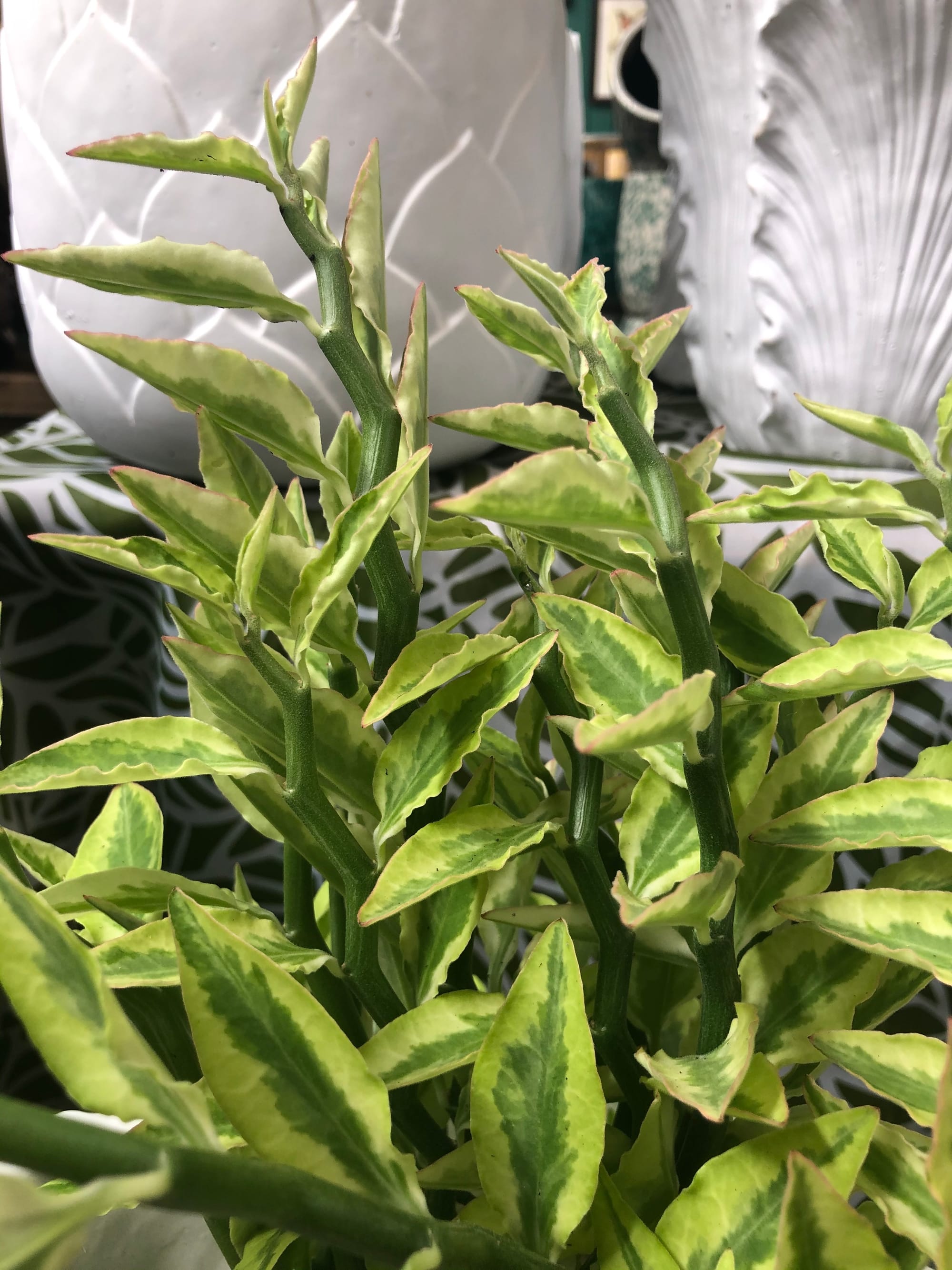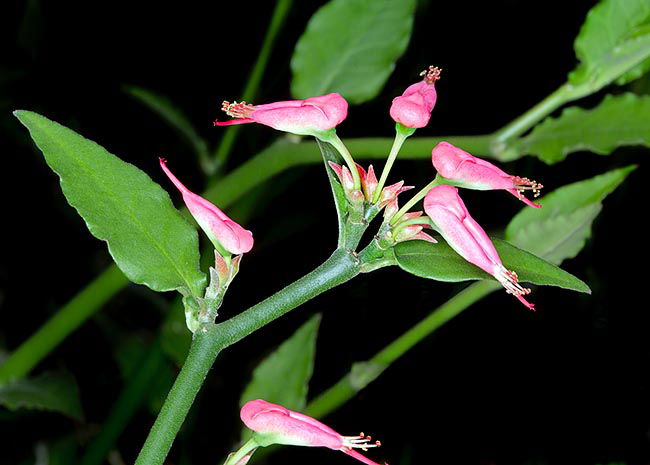
Euphorbia tithymaloides 'Variegatus' - Formally known as 'Pedilanthus tithymaloides'.
Contents
- Top Tips
- Location, Water, Humidity & Fertilisation
- Common Issues
- Origins, Temperature, Propagation, Repotting & Toxicity.
Need the answer to a specific plant query? Book a 1-to-1 video call with THE HOUSEPLANT DOCTOR™, the website's friendly author, to overcome and address your niggling problem! Available on iMessage, WhatsApp, Facebook Messenger & more.
Top Tips & Info
- Care Difficulty - Easy
- Provide a bright location with a splash of either morning or evening sunlight for quality growth.
- Allow the soil's top half to dry in between waters, reducing this slightly further in the autumn and winter.
- A good level of humidity and air circulation is crucial for a long-lasting specimen.
- Fertilise using a 'Houseplant' labelled feed every four waters in the spring and summer, reducing this to every six in the colder months.
- Devil's Backbones won't need frequent repotting, so once every three years is best to avoid transplant shock, using a 'Cactus & Succulent' potting mix.
- Pests aren't usually an issue; however, keep an eye out for Mealybugs & Scale.
Location & Light - 🔸🔸🔸
A minimal amount of morning or evening sunlight is fantastic for Devil's Backbones. Specimens kept on a shelf where the soil line isn't in view of the natural light must follow the rule of 'near-drenches between droughts'. We'd recommend a windowsill, or a nearby table is the perfect location for this plant, as a lack of natural light penetrating the compost's face may result in root rot and soil mould. Bright, indirect location is still advised; however, you must keep on the drier side to avoid over-watering from its moisture-retentive leaves.
Water - 🔸🔸
Those kept in the traditional pots must have the soil's top half to dry in between waters. To confirm that your specimen needs a water, feel the weight of the pot and if it still feels heavy, allow the pot to become slightly lighter before another hydration. It's always better to under-water Devil's Backbones than over-do it, so if you're unsure as to when it needs a drink, leave it for another few days!
Humidity -🔸
Average room humidity is more than enough to satisfy this plant. Never situate it within a few metres of an operating radiator due to the enriched chance of crisping foliage.
Fertilisation - 🔸🔸
Feed every four waters during the growing period and every six in the autumn and winter, using a 'Houseplant' or 'Cactus' labelled fertiliser. Never apply a 'Ready to Use’ product into the soil without a pre-water first, as it may burn the roots and lead to yellowed leaves.
Common Issues with Devil's Backbones
Root or leaf rot is a common issue among specimens sat in too dark environments with prolonged soil moisture. Symptoms include yellow or rotten leaves, mouldy soil, stunted growth and a rotten base resting against the soil. Take the plant out of the pot and inspect health below the compost line. If the roots sport a yellow tinge, you're good to go, but if they're brown and mushy, action must be taken immediately. More information about addressing root rot can be found on this link.
A lack of leaves on the soil's face could be the product of excess moisture settling on the foliage. Although watering from the top is best, it's recommended to use the bottom-up method if you're a messy waterer. For specimens that have a bare head, improve growing conditions by using this method and increasing the light levels and air circulation. Take stem cuttings to promote a bushier appearance above the soil line - scroll down to 'Propagation' for more information. Finally, always remove yellowed or rotten debris from the soil as it could harbour both bacterial and fungal diseases which will continue the plant's decline.
Too much sunlight will lead to sun scorch, with typical signs including browning or crispy leaves, dry leaf-edges, sunken leaves or stunted growth. Although too little light will cause over-watering issues, excess sunlight will be a detriment to the plant as well. If yours has fallen short of this, reduce the amount of the sun considerably and always be mindful of environmental shock (when two locations offer too different growing conditions). Remove some of the affected leaves and increase waters slightly.
Origins
The species was described back in 1753 by Carl Linnaeus as 'Euphorbia tithymaloides'. He placed it in the newly-constructed Euphorbia, along with honouring the similarities between it and the genus of Tithymalus. The synonym, Pedilanthus tithymaloides, was first penned by Pierre-Antoine Poiteau in 1812, placing it in this genus due to the similarities of the shoe-shaped flowers.
 The Distribution of Euphorbia tithymaloides.
The Distribution of Euphorbia tithymaloides.
Temperature
12° - 30°C (50° - 86°F)
H1b (Hardiness Zone 12) - Can be grown outdoors during the summer in a sheltered location with temperatures above 12℃ (54℉), but is better to remain indoors, too. If you decide to bring this plant outdoors, don't allow it to endure any direct sunlight as it may result in sun-scorch and dehydration. Regularly keep an eye out for pests, especially when re-introducing it back indoors.
Spread
Up to 1m in height and 0.3m in width, with the ultimate height being reached in 5 - 8 years. Expect around 5 - 10cm (2 - 3.5 inches) of new growth per season.
Pruning & Maintenance
Remove yellow or dying leaves, and plant debris to encourage better-growing conditions. While pruning, always use clean utensils or shears to reduce the chance of bacterial and fungal diseases. Never cut through yellowed tissue as this may cause further damage in the likes of diseases or bacterial infections. Remember to make clean incisions as too-damaged wounds may shock the plant, causing weakened growth and a decline in health.
Propagation
Via Seed or Stem Cuttings.
Stem Cuttings
- Choose the healthiest, most established branches from the leading growths. Those that are around 15cm (5 inches) are most likely to root due to stored energy and growth rates. Cut directly between two of the leaves, approximately 15cm from the stem's terminal, using a clean pair of scissors to reduce bacteria count. Remove the lower half of the leaves, too.
- Keep the specimen on a moist paper towel for a few days before placing it into the soil. This will not only callus the wound for better root growth, but it'll also reduce the risk of blackleg.
- Use a 7cm (2.7 inches) pot that has suitable drainage holes - plastic or terracotta are both acceptable in this instance. 'Cactus & Succulent' labelled composts are best as they'll provide adequate drainage and airflow around the roots. Alternatively, place the cutting back into the soil of the mother plant to promote a bushier appearance, as mentioned in 'Common Issues'.
- Set the cutting into the compost, keeping the foliage above the soil line. Be sure to submerge the bottom nodes into the soil, or else root development will hinder. A severe disease that can threat most cuttings is 'Blackleg', which occurs when the bottom wound becomes infected, typically caused by water-logging with too little light.
- Avoid direct sunlight and maintain near-moist soil to prevent dehydration. After twelve weeks in the compost, treat the specimen as a mature plant by following the care advice penned above. Root growth will always develop before new foliage, so bear this in mind if yours is a little slow to get off the mark!
 The flowers of a mature Euphorbia tithymaloides. Copyright: Monaco Nature Encyclopaedia.
The flowers of a mature Euphorbia tithymaloides. Copyright: Monaco Nature Encyclopaedia.
Flowers
Devil's Backbones will produce purple beak-shaped inflorescences during the transition between spring and summer months. Unfortunately, it's doubtful for a Devil's Backbone to bloom indoors, due to the unfavourable growing conditions found in typical domestic settings.
Repotting
Repot every three years in the spring, using a 'Cactus & Succulent' labelled potting mix and the next sized pot with adequate drainage. Devil's Backbones are far better potbound for several years due to the heightened risk of root rot and repotting-issues (like transplant shock), so only repot if you feel it's wholly necessary - restricted root growth will increase the chance of blooms, too.
Hydrate the plant 24hrs before tinkering with the roots to prevent the risk of transplant shock. For those situated in a darker location, introduce an extra amount of perlite and grit into the deeper portion of the pot to downplay over-watering risks. Click on this link for a detailed step-by-step guide on transplantation, or via this link to learn about repotting with root rot.
Pests & Diseases
Keep an eye out for mealybugs, whitefly, root mealybugs, scale & thrips. Typical diseases associated with this genus are leaf-spot disease, botrytis, powdery mildew & root rot. Click here for more information about how to identify and address any of these issues.
Toxicity
This plant is classified as poisonous. If parts of the plants are eaten, vomiting, nausea and a loss of appetite could occur. Consumption of large quantities must be dealt with quickly; acquire medical assistance for further information. Its sap may cause irritation on the skin of sensitive people.
Retail Locations
Online Stores.
Book a 1-to-1 Call with THE HOUSEPLANT DOCTOR™
If you need further advice with your houseplants, book an advice call with ukhouseplants' friendly and expert writer today! This can be done via a video or audio call on most apps, including Facebook, FaceTime & Skype. A ten-minute call costs £5.99 (US$7), or £15.99 for thirty minutes. You can ask multiple questions, including queries on plants, pests, terrariums, repotting advice and anything in between. Please consider supporting this service to keep ukhouseplants thriving!